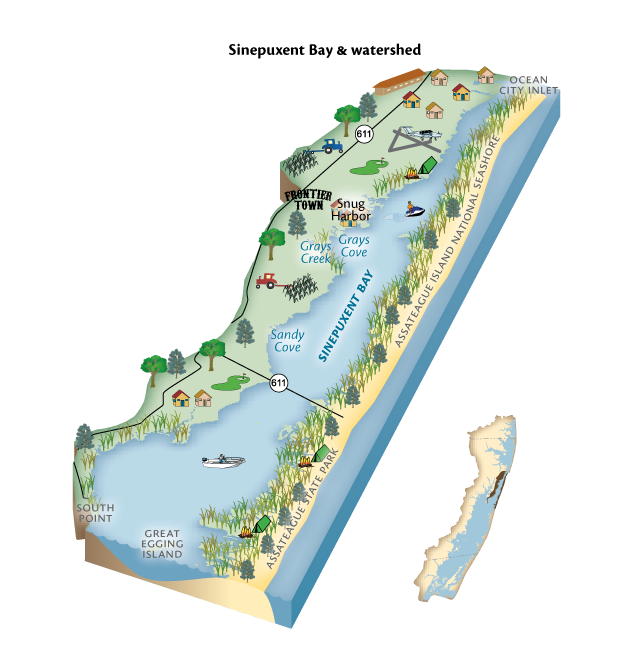
General Description
Sinepuxent Bay’s drainage includes northern Assateague Island and a narrow strip of the mainland south of Route 50, including the Route 611 corridor and land to the east. It is the smallest of the five coastal bays subwatersheds. The bay receives considerable oceanic flushing from the Ocean City inlet.
Ecosystem Health Ranking
- Ranks 1 out of 5
- 2021 Maryland Coastal Bays Report Card
Challenges
Assateague Island is migrating westward primarily due to overwash, a natural process in which waves combine with high tide or storm surge and carry sand from the beach and frontal dunes across the barrier island. The migration of the sand across the island provides the mechanism for the landward migration of the entire island system as sea level rises. This landward migration of Assateague Island has accelerated at the northern end of the island since the opening and subsequent stabilization of the Ocean City Inlet in 1933, which disrupted sediment transport to the northern end of the island. The chronic shoaling presents navigational hazard and a need for regular dredging at the inlet.
Residential development in Sinepuxent watershed includes many large lot subdivisions and waterfront lots. The Route 611 corridor is under increasing development pressure as the urbanized area around West Ocean City continues to expand. Despite being small, the watershed contains nearly 350 septic systems. The greatest source of pollution in this watershed is urban land use.
The watershed contains extensive but eroding tidal wetlands which are impacted by sea level rise and human disturbance. Tidal wetlands and beaches provide crucial habitat for horseshoe crabs, terrapins, a variety of birds and many other organisms. Bay islands are similarly important for habitat and are threatened by erosion and human disturbance.
Key Current Solutions
The U.S. Army Corps of Engineers is assessing long-term solutions to address chronic shoaling in the inlet in partnership with the state of Maryland and Worcester County. That study effort is ongoing and the tentative plan going forward is still to make a recommendation by fall 2020; complete the environmental assessment and design by spring 2021; and be ready to start construction in late 2021.
Skimmer Island, in Sinepuxent Bay, which had become severely eroded due to sea level rise, was rebuilt with dredged sand in 2009, in a cooperative effort of MCBP, the state of Maryland and Ocean City Fishing Center. The island provides crucial habitat for a variety of colonial waterbirds, such as skimmers and terns. This is an ongoing project.
The Mystic Harbor Wastewater Treatment Plant was upgraded and expanded in 2014. The new plant has improved nutrient reduction through a variety of technologies including spray irrigation. The additional capacity is being used to connect existing properties on septic systems and will support infill development on Route 611.
How You Can Help
- Plant native trees and other plants on your property
- Reduce or eliminate use of fertilizer
- Clean up after your pet
- Reduce travel by vehicle—combine trips or walk/bike
- Learn about the watershed you live in and it’s natural resources—volunteer, visit a park or attend informational events about the coastal bays
- Install a rain barrel or a rain garden to treat stormwater
- Get your septic system pumped regularly and ensure it is working optimally
- Enhance your shoreline with native species and eliminate invasive non-native species such as Phragmites
- Respect beach and island closures; these are often short-term closures established to protect nesting birds or other wildlife
